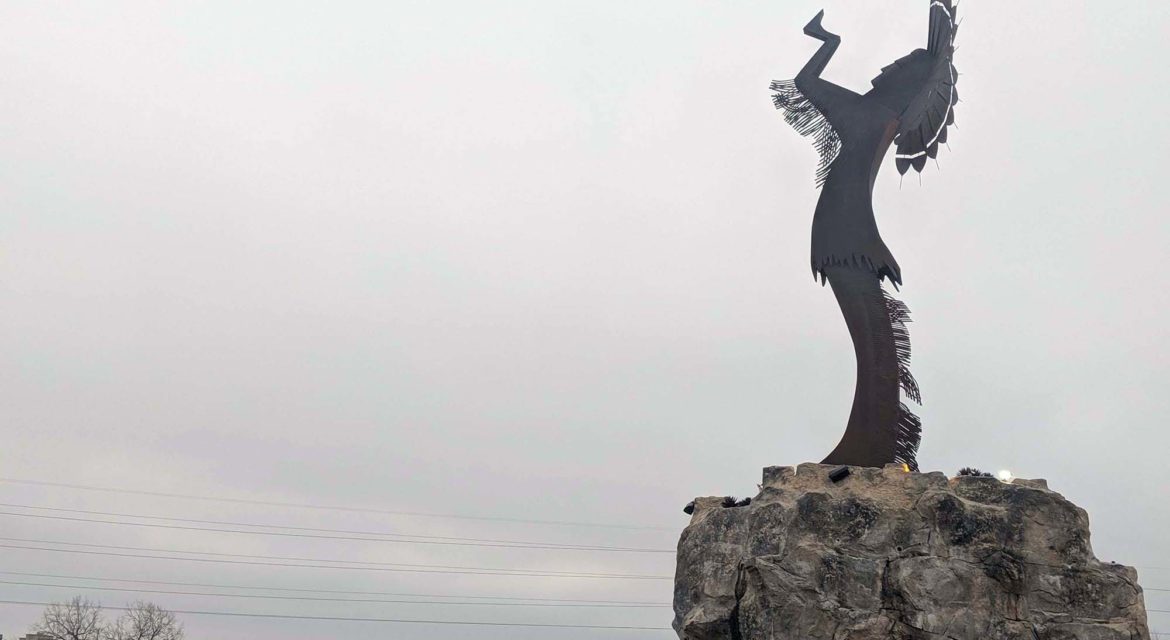 The Keeper of the Plains sculpture has become one of the most recognized symbols in Wichita, Kansas. Rising above the banks of the nearby river, the sculpture and plaza incorporate the symbols, words and history of the local tribes that used to inhabit this area. In doing so, the Keeper of the Plains sculpture showcases what it means to create a monument that is directly tied to the culture of the region for the benefit of the entire community.
The Keeper of the Plains sculpture has become one of the most recognized symbols in Wichita, Kansas. Rising above the banks of the nearby river, the sculpture and plaza incorporate the symbols, words and history of the local tribes that used to inhabit this area. In doing so, the Keeper of the Plains sculpture showcases what it means to create a monument that is directly tied to the culture of the region for the benefit of the entire community.

A Sacred Spot Between the Two Rivers
 Standing at the confluence of the Arkansas and Little Arkansas rivers, the Keeper of the Plains is a 44-foot tall steel sculpture. Erected on May 18, 1974 to celebrate the United States bi-centennial by Native American artist Blackbear Bosin, the sculpture stands between the two rivers in a place that is sacred ground to the Native American people from the area. Two suspended footbridges allow people to cross from the north and south river banks to the plaza at the base of the Keeper.
Standing at the confluence of the Arkansas and Little Arkansas rivers, the Keeper of the Plains is a 44-foot tall steel sculpture. Erected on May 18, 1974 to celebrate the United States bi-centennial by Native American artist Blackbear Bosin, the sculpture stands between the two rivers in a place that is sacred ground to the Native American people from the area. Two suspended footbridges allow people to cross from the north and south river banks to the plaza at the base of the Keeper.
A complete renovation of the sculpture and installation of the Keeper of the Plains Plaza in 2006 saw the creation of a new foundation that raised the sculpture 30 feet in the air. The statue can now be seen over the trees and buildings that have sprung up over the years along the river.
The Keeper of the Plains Plaza contains multiple displays which describe the local tribes that used to inhabit this area, as well as several fire pits which sometimes light up to illuminate the statue at night. This “Ring of Fire” event brings people out each evening to see the Keeper and has proven to be draw for the surrounding community and beyond.

“The Ring of Fire”
 The Keeper of the Plains “Ring of Fire” burns during the spring and summer nightly at set time for 15 minutes. Surrounded by a circle of firepots, the event provides residents and visitors with a critical way to engage with the sculpture.
The Keeper of the Plains “Ring of Fire” burns during the spring and summer nightly at set time for 15 minutes. Surrounded by a circle of firepots, the event provides residents and visitors with a critical way to engage with the sculpture.
This engagement has driven the way in which the Keeper has become an icon of Wichita. A profile image of the Keeper of the Plains was adopted by the 22nd Air Refueling Wing, a U.S. Air Force flying unit which is based at nearby McConnell Air Force Base. It also appears in multiple maps to the city and has been incorporated into countless items for sale, further illustrating the economic and cultural impact it has had in Wichita and all of Kansas.
Open nearly all day long and always free, The Keeper of the Plains sculpture has become an important part of the Wichita community. Like other sculptures and monuments that have created a powerful sense of identity for a city, the piece represents an important legacy for the past and future of the entire region and for Kansas as a whole.

Connections Across Multiple Eras of Kansas
 The Keeper of the Plains sculpture has literally kept a watchful eye over Wichita ever since it was erected, as the statue can be seen over the trees and buildings that have sprung up over the years along the river. Audiences can engage with the piece in various ways, whether it’s by viewing the “Ring of Fire” display, taking part in the history in the plaza, or by simply relaxing by the riverbank that it towers over.
The Keeper of the Plains sculpture has literally kept a watchful eye over Wichita ever since it was erected, as the statue can be seen over the trees and buildings that have sprung up over the years along the river. Audiences can engage with the piece in various ways, whether it’s by viewing the “Ring of Fire” display, taking part in the history in the plaza, or by simply relaxing by the riverbank that it towers over.
This literal connection to the community is about something much deeper though, as it extends backward and forward in time, showcasing what it can mean for a sculpture to represent such a powerful impact on the economy and culture of an entire area.

